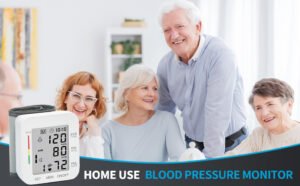High blood pressure, or hypertension, is a widespread medical issue that affects millions of people globally. How to control blood pressure at home is easy. If left untreated, it presents a substantial risk to cardiovascular health, increasing the chance of heart attacks, strokes, and other catastrophic consequences.

The good news is that blood pressure is very controllable, and can be mostly controlled from the comforts of one’s own home. We go into practical methods and approaches for managing blood pressure at home in this extensive tutorial. High blood pressure, or hypertension, is a widespread medical issue that affects millions of people globally. How to control blood pressure at home is easy but tricky.
Understanding Blood Pressure:
Blood pressure is the force that blood flowing through a blood artery applies to its walls. It is composed of two measurements: the diastolic pressure, which shows the pressure in between heartbeats, and the systolic pressure, which shows the pressure during a heartbeat. The usual range for normal blood pressure is less than 120/80 mm Hg; greater values are indicative of hypertension.
Managing Blood Pressure:
Blood pressure control is essential for general health and wellbeing. Long-term damage to blood vessels and organs from persistent hypertension raises the risk of heart disease, stroke, kidney disease, and other dangerous illnesses. People can improve their quality of life and drastically lower their risk of these potentially fatal complications by managing their blood pressure. How to control blood pressure at home by managing it some easy ways.
Risk Factors Associated with High Blood Pressure:
High blood pressure can be caused by a number of variables, including age, nutrition, lifestyle choices, genetics, and underlying medical disorders such diabetes, obesity, and kidney disease.
How To Control Blood Pressure At Home
Furthermore, bad behaviors like smoking, binge drinking, and consuming a lot of salt can make hypertension worse. Effective blood pressure control requires identifying and treating these risk factors.
Lifestyle Changes for Controlling Blood Pressure:
1. Adopting a Healthy Diet:
Blood pressure can be lowered with a well-balanced diet high in fruits, vegetables, whole grains, lean meats, and healthy fats. It has been demonstrated that the Dietary Approaches to Stop Hypertension (DASH) diet is very successful in lowering blood pressure. It places an emphasis on fruits, vegetables, and low-fat dairy products while minimizing cholesterol, sodium, and saturated and trans fats. How to control blood pressure at home by taking healthy diet.
2. Regular Exercise Regimen:
Regular physical activity is essential for blood pressure management. Walking, running, swimming, and cycling are examples of aerobic exercises that strengthen the heart and increase circulation, which lower blood pressure. According to health authorities, try to get in at least 150 minutes of moderate-intensity or 75 minutes of vigorous-intensity exercise each week. How to control blood pressure at home by regular exercise.
3. Managing Stress Levels:
Stress hormones that tighten blood vessels and quicken heart rate are released by the body in response to prolonged stress, which can lead to high blood pressure. By lowering stress levels and fostering relaxation, practices including progressive muscle relaxation, yoga, meditation, and deep breathing can help regulate blood pressure. How to control blood pressure at home by managing stress.
Monitoring Blood Pressure at Home:
Blood Pressure Monitor-SHOP NOW
 BUY NOW
BUY NOW
4. Importance of Regular Monitoring:
Monitoring blood pressure at home on a regular basis is crucial for tracking development and identifying any anomalies or variations. It gives patients the ability to properly manage their disease on their own and gives medical professionals important information to consider when prescribing a course of treatment.
5. Choosing the Right Blood Pressure Monitor:
Choose a blood pressure monitor that meets your needs and budget, ensuring it is verified and accurate. For simplicity and dependability, automatic digital monitors with cuff sizes suitable for your arm circumference are usually advised. For accurate readings, make sure the gadget is properly calibrated and maintained.
6. Proper Technique for Taking Blood Pressure Measurements:
To get accurate readings when taking your blood pressure at home, use the right approach. Before taking any measures, take a seat quietly with your feet flat on the floor and your back supported for at least five minutes. Snugly wrap the cuff around your upper arm at heart level. During the measurement, do not move or speak. Record the results of several readings you take during the day for monitoring and analysis.
Natural Remedies and Supplements:
7. Incorporating Potassium-Rich Foods:
Because it relaxes blood vessel walls and offsets the effects of sodium, potassium is essential for controlling blood pressure. To naturally lower blood pressure, eat more foods high in potassium, such as sweet potatoes, bananas, oranges, potatoes, spinach, and avocados. How to control blood pressure at home by taking potassium rich foods.
8. Utilizing Herbal Supplements:
It has been demonstrated that several herbal supplements may have blood pressure-lowering properties. Garlic, hawthorn, hibiscus, and fish oil are a few examples. But before beginning any herbal supplement routine, it’s imperative to speak with a healthcare provider, as some people may experience negative effects or interactions with drugs from herbal supplements. How to control blood pressure at home by using herbal supplements.
9. Exploring Other Natural Remedies:
When combined with a healthy lifestyle, a number of additional natural therapies, including coenzyme Q10, magnesium, and omega-3 fatty acids, may also help lower blood pressure. However, the scientific literature on their efficacy is conflicting, and further studies are required to establish their effects.
Medication Management:
10. Importance of Medication Adherence:
Following a doctor’s prescription is essential for managing blood pressure and avoiding complications in those with hypertension who need medication. Regarding the amount, frequency, and timing of your medications, heed the advice of your healthcare practitioner. You should also report any adverse effects or concerns as soon as possible.
11. Understanding Common Blood Pressure Medications:
Diuretics, beta-blockers, ACE inhibitors, angiotensin II receptor blockers (ARBs), calcium channel blockers, and other drug types are frequently recommended to treat hypertension. Based on your unique needs and medical history, your healthcare practitioner will choose the best medicine to lower your blood pressure. Each type of drug works differently in this regard.
12. Seeking Professional Guidance and Regular Checkups:
Even though there are many parts of blood pressure management that may be handled at home, it’s crucial to consult a healthcare practitioner on a regular basis and seek professional help. In addition to evaluating your general health and monitoring your blood pressure and medication as needed, they can offer helpful advice and assistance when it comes to making lifestyle changes.
Conclusion
Giving people the knowledge and resources to manage their blood pressure at home is crucial for promoting long-term health and well-being. Controlling blood pressure at home can be achieved through a comprehensive approach that includes lifestyle modifications, regular monitoring, natural remedies, medication management, and professional guidance. This can be achieved through adopting a healthy diet, exercising regularly, managing stress, monitoring blood pressure at home, incorporating natural remedies and supplements, adhering to prescribed medications, and seeking regular medical care.
